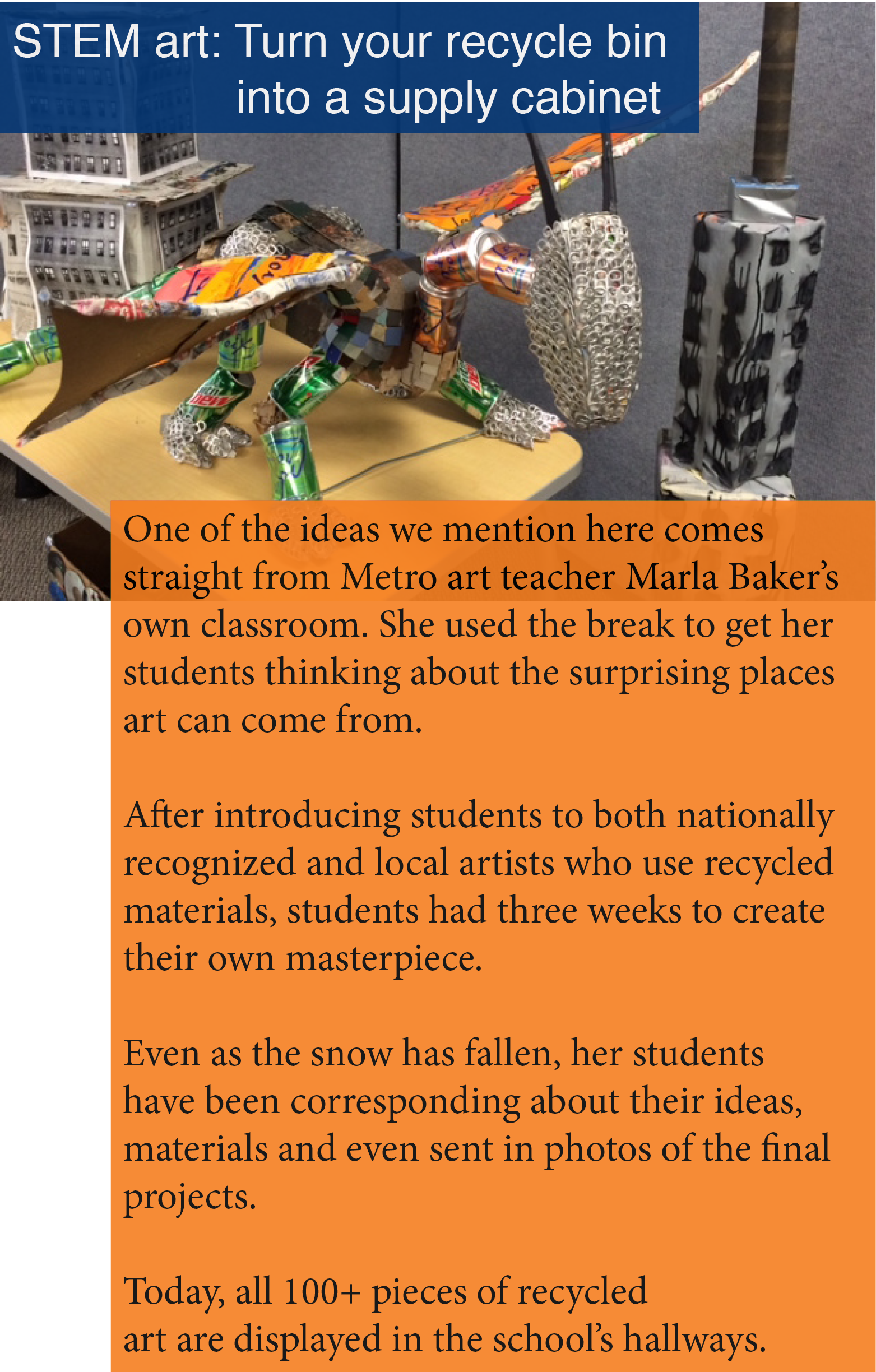Let’s face it, school has been closed a lot this year, and there may be more to come. But even a day at home can be a powerful time for learning.
Here are a few ideas from Jordan Walker and Marla Baker, teachers at the Metro Early College school, on how to keep learning even when the snow closes school.
Idea #1: Gummy bears + water = science
Osmosis. It’s tricky to say but easy to understand. Here’s how to demonstrate it with some candy and water.
Fill a clear cup or glass 3/4 full with lukewarm water. Then ask your young scientist to place one or two gummy bears in the cup. A few hours later, check back. Your waterlogged gummy will have grown at least twice as large. That’s because water naturally tries to fill dry places, like the inside of the gummy bear. We call that process osmosis. (Update: We’ve had a couple of folks write in suggesting this experiment’s really a better example of diffusion, not osmosis. Click here or scroll down for the full explanation.)
Questions to ask: Can you describe how the gummy bear changed? What do you think happened?
STEM habits: Inquiry, observation, critical thinking.
Idea #2: Create art from surprising materials
For this project, you’ll just need some art materials (glue, scissors, tape) and the willingness to rinse out some old recycling. Don’t worry too much about having any one specific item.
Art can help students work through complex topics. To help her class consider what counts as art and what happens to the things we throw away, Metro teacher Marla Baker issued this challenge: Create a piece of art without purchasing any new materials.
To do this project at home with your child, first, ask your child to write out a few art projects he or she would like to create. Remember to be open-minded. Marla’s rules were simple: the final product has to be 3-dimensional and fit on a table.
Then, pull out the recycle bin. With your child, conduct an inventory of what materials you have available.
Now, get to building. When problems come up, be sure to let your enterprising artist provide the solutions—it’s best for you to provide input once the project is complete.
Questions to ask: How can we make this work? What did you think you’d make at first? Did your idea change? Why did it change?
STEM habits: Creativity, observation, problem-solving.
Idea #3: Inflate a balloon with yeast, sugar, and a dash of chemistry
This one’s a little trickier, but stick with it. With just a balloon, one packet of active dry yeast, a little sugar, and a water bottle, you’ll be able to show your learner about the chemistry that makes bread rise.
First, stretch out the balloon by blowing it up and letting the air out at least twice. Heat up 1 cup of water until it’s very warm. (You’re going for about 100 degrees Fahrenheit. Start with cold water and warm it for 25 seconds in a regular microwave.)
Carefully mix in the active yeast and two tablespoons of regular granulated sugar. Once these have dissolved, pour the mixture into a small empty water bottle. Wrap the mouth of the balloon securely over the mouth of the bottle and let it rest on a flat surface.
With the gummy bears, we gave you some questions to ask after the experiment was over. Here, try to get your lab-partner to predict what’s going to happen and then guess why. (To see for yourself, check out this YouTube video)
Questions to ask: What do you think is going to happen?
STEM habits: Observation, critical thinking, communication.
About the Ohio STEM Learning Network:
We believe that quality STEM education is the best way for children to develop the knowledge and skills they need to succeed. To help bring these opportunities to all Ohio students, we work with teachers, school administrators and a network of regional STEM leaders to create great educational experiences. Today, we’re supported by the State of Ohio, Battelle, and other advocates for education in Ohio.
About Metro Early College:
Metro Early College is a small and intellectually vibrant learning community designed to serve students who want a personalized learning experience that prepares them for a connected world where math, science and technology are vitally important. All Metro students engage in a personally relevant and academically rigorous curriculum within a safe and trusting environment. Metro Early College is supported by Battelle, the Ohio State University, and other partners in the Columbus community.
By reader request: Diffusion vs Osmosis – the gory details
Our original description of the gummy bear experiment described it as an example of osmosis. It’s a little more complicated than that.
Let’s start with diffusion. Properly speaking, diffusion is the process of particles spreading out to fill a new space. In our case, that new space is the inside of the gummy. So why even bring up osmosis? Because it’s a core mechanism used by the human body and closely linked to diffusion.
Our bodies are a regular diffusion circus. But cells don’t just let water and other particles rush in and out. They control that process by using choosy barriers, including cell membranes. These barriers are called “semi-permeable membranes.” Permeable – because they will often let particles in or out. Semi-permeable – because they only let certain substances in or out.
That kind of choosy diffusion, that is osmosis. Our water-logged gummy doesn’t have those membranes and can’t be choosy about what’s rushing in or out, so it’s just showing the force that drives osmosis, (diffusion) not the whole process.
For a detailed explanation, hit play on this explainer from Khan Academy.

